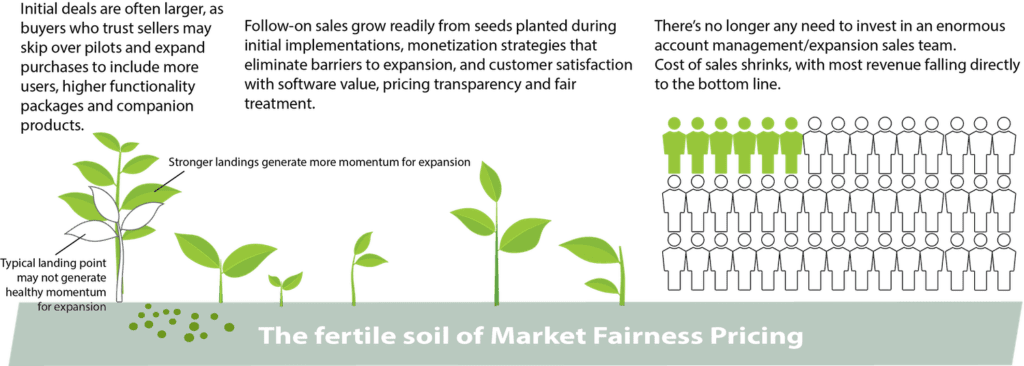Increase the size of initial sales and ease of expansion sales
There are places in this country where the soil is so rich locals joke you can grow crops just by spilling a drop of water on the ground. There are also places where the soil is so rocky and bound up with clay that water poured onto the ground just sits there, going nowhere, nourishing nothing.
My observation is that many software companies are struggling to grow revenues and customer relationships in infertile soil. Common approaches to software pricing—copying competitors, modeling historical data misaligned with current value, making loads of discretionary, random and bespoke deals, using unproven methods to gauge customer price sensitivity, charging buyers differently for the same product/service sets—put rocks in the soil of customer relationships and gum up sales processes.
These practices make it difficult for salespeople to clearly explain pricing and defend value. They erode trust, often causing buyers to pull back from an ideal use case deployment to pilots or to take other risk mitigation measures. Initial deals may take longer. Deployments may be shallow, not fully rooting into operations. Subsequent deals, which ought to sprout naturally from seeds of the first, instead take massive cultivation efforts by costly account management teams, for profits that never reach full potential.
A different approach, which we call Market Fairness Pricing, creates richer soil for growing software revenues and customer relationships. It’s a strategic, systematic, data-driven software monetization method encompassing licensing, packaging and pricing model (with a structured discounting framework). These modern techniques are layered over the bedrock of a fundamental commitment to the principle of market fairness: Buyers who purchase the same set of products and services at the same volume should pay the same price.
Here are some of the ways Market Fairness Pricing can help you make bigger initial and follow-on sales:
Flip your software sales strategy: “Expand to land” is better for growth
“Land and expand” is a near-universal goal in software sales. Too often, though, it proves to be an empty promise with hidden costs. The envisioned expansion never fully materializes, and act-of-good-faith price concessions become anchors on the books, creating friction for future sales.
A better way to grow revenues and relationships is to help buyers expand their thinking during the initial sale. If your company’s approach to software monetization is transparent and systematic, salespeople acquire what we call pricing fluency. They easily tour prospects across the landscape of how your pricing works. In an efficient, collaborative manner, seller and buyer explore a range of options, eliminating the need for dozens of quotes. Buyers gravitate to the place in the landscape that works best for them, and from there request a smaller number of well-focused quotes for variations on the use case(s) they really want.
This approach also helps buyers look ahead to understand what their future software costs might look like if they should choose to add more users, packages of higher functionality or companion products. Frequently, the trust engendered by pricing that’s rational, transparent and easy to understand encourages buyers to wrap some or all of these additions into the initial purchase. Even when that’s not the case, future sales tend to flow naturally—you don’t need an army of account managers focused on sale expansion.

Align pricing with how different groups use your software and derive value from it
To keep the soil fertile for future sales, software pricing must work as well for future groups of users as for initial users. Some of them may use the software differently or derive less value from it.
If your licensing metric, packaging, pricing and incentives don’t anticipate and accommodate this variability, they can become barriers to natural expansion. Buyers who perceive their future costs as excessive will hesitate to roll out software to additional users. Or they’ll push back for deeper discounts, lessening what would otherwise be a strong revenue shot directly to your bottom line.
You can avoid these growth barriers by anchoring your monetization strategy in detailed quantitative and qualitative analyses that provide insight into the complexities of your customer mix and how different types of users derive value from your software. The resulting insights will point to clever ways of packaging software functionality and pricing the packages so that customers see a clear, economically compelling path to additional purchases.
Seed your next sale, and the next, …
The ease and speed of follow-on sales depend on whether you’ve achieved a strong initial deal configuration. Under pressure to close or just make any kind of landfall, sales teams sometimes fail to fully envision the customer journey and provision for that expansion path.
For instance, I’ve mentioned shallow deployments that aren’t firmly rooted in operations. Maybe your initial sale addressed only part of a business process, leaving workflows marbled with manual tasks. If there are no clear paths for addressing other parts of the process, forward sales momentum will stall out. Eventually, your software will be seen as functionally limited, only a partial solution, leaving the door open for competitors to complete or replace it.
In Market Fairness Pricing, sales teams have a complete monetization framework that covers both initial and expansion sales. A key piece of this framework is a packaging strategy that accommodates the complexities of your customer mix and use cases—and evolves if these change over time.
Sales teams also have data-driven, interactive pricing fluency tools. They use them to demonstrate that your pricing is fairly applied to all buyers and to show how discounts and other incentives can be earned initially and through additional purchases. This pricing transparency and consultative selling, along with customer satisfaction with proven value, create fertile soil for continued expansion of revenues and relationships.
Looking for richer soil? Take a deeper look…
Find out more about increasing sales momentum and account value by downloading our ebook on Three Ways to Make Sure Your Land & Expand Strategies Actually Expand. Or contact me at chrismele@softwarepricing.com. To learn about reducing your risk when making software pricing changes, check out our post on the five fundamentals of software pricing risk.
